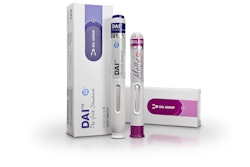This content was written and submitted by the supplier. It has only been modified to comply with this publication’s space and style.
BD Rx Inc., a wholly-owned subsidiary of leading global medical technology company BD (Becton, Dickinson and Company) (NYSE: BDX), announced today that the U.S. Food and Drug Administration (FDA) has approved Morphine Sulfate Injection, USP to be offered in the BD Simplist line of ready-to-administer prefilled injectables in the most common strengths: 2mg/mL, 4mg/mL, 5mg/mL, 8mg/mL and 10mg/mL. Morphine Sulfate Injection, USP is indicated for the management of pain not responsive to non-narcotic analgesics.
"The launch of an FDA approved morphine product at a time of heightened need is an important step in our plans to drive clinical practice improvements," said Mark Sebree, President, BD Rx. "The expansion of the BD Simplist product line demonstrates our commitment to providing our hospital and surgical center customers with drugs in high-demand today."
BD Rx will begin production of morphine immediately and projects initial product availability in early calendar year 2014.
This approval marks the fourth in a series of 20 to 30 drugs that BD Rx plans to launch in the BD Simplist prefilled injectables product line in the coming years. The first three drugs launched in the past year are Diphenhydramine Hydrochloride Injection, USP, Metoclopramide Injection, USP and Ondansetron Injection, USP 4mg/2mL (2mg/2mL). The company plans to focus on the therapeutic categories primarily used by clinicians in the hospital and surgical center settings, including pain management, anesthetics, cardiovascular agents and antiemetics.
BD Simplist prefilled injectables are designed to help improve patient care and safety by decreasing the number of steps in the traditional vial and syringe injection sequence, helping to reduce the potential risk of medication error and allowing for more focus on the patient and less on injection preparation. Clinicians perform up to 20 steps in a traditional vial and syringe injection sequence. BD Simplist prefilled injectables reduce the injection sequence to approximately 12 steps.
About Morphine Sulfate Injection, USP
INDICATIONS AND USAGE
Morphine sulfate is an opioid agonist indicated for the management of pain not responsive to nonnarcotic analgesics.
IMPORTANT SAFETY INFORMATION
CONTRAINDICATIONS
Morphine sulfate is contraindicated in:
• patients with known hypersensitivity to morphine
• patients with respiratory depression in the absence of resuscitative equipment
• patients with acute or severe bronchial asthma or hypercarbia
• any patient who has or is suspected of having paralytic ileus
Risk of Medication Errors
It is important to take care when prescribing and administering the injection to avoid dosing errors due to confusion between different concentrations and between mg and mL, which could result in accidental overdose and death.
Cardiovascular Instability
While low doses of intravenously administered morphine have little effect on cardiovascular stability, high doses are excitory, resulting from sympathetic hyperactivity and increase in circulatory catecholamines. Have Naloxone Injection and resuscitative equipment immediately available for use in case of life-threatening or intolerable side effects and whenever morphine therapy is being initiated.
Respiratory Depression
Respiratory depression is the primary risk of Morphine Sulfate Injection USP. Respiratory depression occurs more frequently in elderly or debilitated patients and in those suffering from conditions accompanied by hypoxia, hypercapnia or upper airway obstruction, in whom even moderate therapeutic doses may significantly decrease pulmonary ventilation. Morphine administration should be limited to use by those familiar with the management of respiratory depression. Rapid intravenous administration may result in chest wall rigidity.
Patients with chronic obstructive pulmonary disease or cor pulmonale and in patients having a substantially decreased respiratory reserve (e.g., severe kyphoscoliosis), hypoxia, hypercapnia or pre-existing respiratory depression have an increased risk of increased airway resistance and decrease respiratory drive to the point of apnea with use of Morphine Sulfate Injection USP. Therefore, consider alternative non-opioid analgesics, and use Morphine Sulfate Injection USP only under careful medical supervision at the lowest effective dose in such patients.
Central Nervous System (CNS) Toxicity
Excitation of the central nervous system, resulting in convulsion, may accompany high doses of morphine given intravenously. Dysphoric reactions may occur after any size dose and toxic psychoses have been reported.
Central Nervous System (CNS) Depressants
The depressant effects of morphine are potentiated by the presence of other CNS depressants such as alcohol, sedatives, antihistamines or psychotropic drugs. Use of morphine in conjunction with other CNS active drugs may increase the risk of respiratory depression, hypotension, profound sedation, coma, or death.
Increased Intracranial Pressure or Head Injury
Use Morphine Sulfate Injection with extreme caution in patients with head injury or increased intracranial pressure. In the presence of head injury, intracranial lesions or a preexisting increase in intracranial pressure, the possible respiratory depressant effects of Morphine Sulfate Injection USP and its potential to elevate cerebrospinal fluid pressure (resulting from vasodilation following CO2 retention) may be markedly exaggerated. Pupillary changes (miosis) from morphine may obscure the existence, extent and course of intracranial pathology. Clinicians should maintain a high index of suspicion for adverse drug reactions when evaluating altered mental status or movement abnormalities in patients receiving this modality of treatment.
Hypotensive Effect
Morphine sulfate may cause severe hypotension in an individual whose ability to maintain their blood pressure has been compromised by a depleted blood volume, shock, impaired myocardial function or concurrent administration of sympatholytic drugs, and drugs such as phenothiazines or general anesthetics. Orthostatic hypotension is a frequent complication in single-dose parenteral morphine analgesia in ambulatory patients.
The vasodilation produced by Morphine Sulfate Injection USP may further reduce cardiac output and blood pressure in patients in circulatory shock.
Gastrointestinal Effects
Do not administer Morphine Sulfate Injection USP to patients with gastrointestinal obstruction, especially paralytic ileus because Morphine Sulfate Injection USP diminishes propulsive peristaltic waves in the gastrointestinal tract and may prolong the obstruction.
The administration of Morphine Sulfate Injection USP may obscure the diagnosis or clinical course in patients with acute abdominal condition.
Use in Biliary Surgery or Disorders of the Biliary Tract
Morphine sulfate should be used with caution in patients with biliary tract disease, including acute pancreatitis, as morphine sulfate may cause spasm of the sphincter of Oddi and diminish biliary and pancreatic secretions.
Exposure, Hypothermia, Immersion and Shock
Caution must be used when injecting any opioid intramuscularly into chilled areas or in patients with hypotension or shock, since impaired perfusion may prevent complete absorption; if repeated injections are administered, an excessive amount may be suddenly absorbed if normal circulation is re-established.
Special Risk Groups
Use Morphine Sulfate injection in reduced dosages in patients with severe renal or hepatic impairment, Addison's disease, hypothyroidism, prostatic hypertrophy, or urethral stricture, and in elderly or debilitated patients. Monitor these patients closely for signs of respiratory and central nervous system depression.
ADVERSE REACTIONS
Serious adverse reactions associated with Morphine Sulfate Injection USP include, respiratory depression, apnea, and to a lesser degree, circulatory depression, respiratory arrest, shock and cardiac arrest. Rarely, anaphylactoid reactions have been reported when morphine or other phenanthrene alkaloids of opium are administered intravenously.
The most frequently observed adverse reactions include sedation, lightheadedness, dizziness, nausea, vomiting, constipation and diaphoresis.
DRUG INTERACTIONS
• CNS depressants: Increased risk of respiratory depression, hypotension, profound sedation and coma
• Muscle relaxants: May enhance the neuromuscular blocking action of skeletal muscle relaxants and produce respiratory depression
• Mixed agonist/antagonist opioid analgesics: May reduce the analgesic effect and/or may precipitate withdrawal symptoms
• Cimetidine: May increase respiratory and CNS depression
• Monoamine Oxidase Inhibitors (MAOIs): Potentiate the action of Morphine Sulfate Injection USP
• Anticholinergics: May increase the risk of urinary retention, severe constipation, or paralytic ileus
USE IN SPECIFIC POPULATIONS
• Pregnancy: Based on animal data, may cause fetal harm
• Pediatric patients: Safety and effectiveness and the pharmacokinetics of Morphine Sulfate Injection in pediatric patients below the age of 18 have not been established.
• Geriatric patients: Use caution during dose selection, starting at the low end of the dosing range while carefully monitoring for side effects.
• Renal and hepatic management: Start patients at lower doses and titrate slowly while carefully monitoring
Before administering Morphine Sulfate Injection, please read the full prescribing information.
About Diphenhydramine Hydrochloride Injection, USP
INDICATIONS AND USAGE
Diphenhydramine Hydrochloride Injection, USP is effective in adults and pediatric patients, other than premature infants and neonates, when diphenhydramine hydrochloride in the oral form is impractical.
For amelioration of allergic reactions to blood or plasma, in anaphylaxis as an adjunct to epinephrine and other standard measures after the acute symptoms have been controlled, and for other uncomplicated allergic conditions of the immediate type when oral therapy is impossible or contraindicated. For active treatment of motion sickness and for use in parkinsonism, when oral therapy is impossible or contraindicated in the elderly who are unable to tolerate more potent agents; mild cases of parkinsonism in other age groups, and in other cases of parkinsonism in combination with centrally acting anticholinergic agents.
IMPORTANT SAFETY INFORMATION
Diphenhydramine hydrochloride is contraindicated in neonates, premature infants, and as antihistamine therapy in nursing mothers and as a local anesthetic and when a patient is hypersensitive to other antihistamines of similar chemical structure.
Considerable caution should be used in patients with narrow-angle glaucoma, stenosing peptic ulcer, pyloroduodenal obstruction, symptomatic prostatic hypertrophy, or bladder-neck obstruction.
Local necrosis has been associated with the use of subcutaneous or intradermal use of the drug. It has an atropine-like action and, therefore should be used with caution in patients with a history of bronchial asthma, increased intraocular pressure, hyperthyroidism, cardiovascular disease or hypertension and in patients with lower respiratory disease including asthma.
It has additive effects with alcohol and other CNS depressants. MAO inhibitors prolong and intensify the anticholinergic (drying) effects of antihistamines.
The most frequent adverse reactions are: Nervous System: sedation, sleepiness, dizziness, disturbed coordination; GI System: epigastric distress; and Respiratory System: thickening of bronchial secretions
Please see diphenhydramine full prescribing information for additional important safety information.
About Metoclopramide Injection, USP
INDICATIONS AND USAGE
Metoclopramide Injection, USP is indicated for:
• the relief of symptoms associated with acute and recurrent diabetic gastric stasis
• prophylaxis of vomiting associated with emetogenic cancer chemotherapy
• the prophylaxis of postoperative nausea and vomiting in those circumstances where nasogastric suction is undesirable.
Metoclopramide Injection, USP also may be used to:
• facilitate small bowel intubation in adults and pediatric patients in whom the tube does not pass the pylorus with conventional maneuvers
• stimulate gastric emptying and intestinal transit of barium in cases where delayed emptying interferes with radiological examination of the stomach and/or small intestine.
IMPORTANT SAFETY INFORMATION
• Metoclopramide treatment can cause tardive dyskinesia, a serious movement disorder that is often irreversible. Therapy should be discontinued in patients who develop signs or symptoms of tardive dyskinesia. Treatment for longer than 12 weeks should be avoided in all but rare cases.
• Metoclopramide is contraindicated whenever stimulation of gastrointestinal motility might be dangerous; in patients with pheochromocytoma; in patients with epilepsy or taking drugs which are likely to cause extrapyramidal reactions; or patients with known sensitivity or intolerance to the drug.
• Metoclopramide can cause serious side effects including abnormal muscle movements, uncontrolled spasms of the face and neck muscles, or muscles of the body, arms, and legs, depression, thoughts of suicide, and suicide, and rarely but serious Neuroleptic Malignant Syndrome and Parkinsonism.
• The most common side effects of Metoclopramide Injection include feeling restless, sleepy, tired, dizzy, or exhausted, headache, confusion and trouble sleeping.
For additional Important Safety Information, please see the metoclopramide full prescribing information including BOXED WARNINGS and Medication Guide.
About Ondansetron Injection, USP 4mg/2mL (2mg/mL)
INDICATIONS
Ondansetron Injection is a 5-HT3 receptor antagonist indicated for:
Prevention of nausea and/or vomiting postoperatively and with initial and repeat courses of emetogenic cancer chemotherapy.
IMPORTANT SAFETY INFORMATION
Ondansetron Injection is contraindicated in patients know to have hypersensitivity (e.g. anaphylaxis) to this product or any of its components and in the concomitant use of apomorphine.
Hypersensitivity reactions including anaphylaxis and bronchospasm have been reported in patients who have exhibited hypersensitivity to other selective 5-HT3 receptor antagonists. QT prolongation occurs in a dose-dependent manner. Torsades de Pointes have been reported. Avoid Ondansetron in patients with congenital long QT syndrome. Use in patients following abdominal surgery or in patients with chemotherapy-induced nausea and vomiting may mask a progressive ileus and/or gastric distention.
The most common adverse reactions in adults are headache, diarrhea and fever. In pediatric patients (ages 1 to 24 months), the most common adverse reaction is diarrhea.
For additional important safety information, please see the Ondansetron full prescribing information.






















